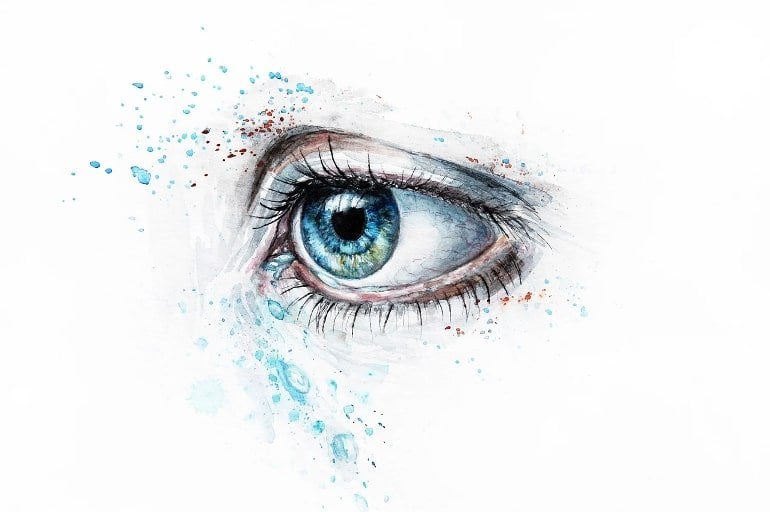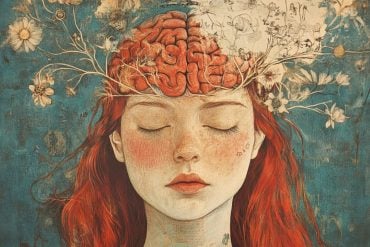Summary: Using EEG data, researchers discovered children on the autism spectrum do not automatically process illusory shapes as well as children not on the autism spectrum. The findings suggest something is going awry in the feedback-processing pathways in the brains of those with autism.
Source: University of Rochester
There is this picture – you may have seen it. It is black and white and has two silhouettes facing one another. Or maybe you see the black vase with a white background. But now, you likely see both.
It is an example of a visual illusion that reminds us to consider what we did not see at first glance, what we may not be able to see, or what our experience has taught us to know – there is always more to the picture or maybe even a different image to consider altogether.
Researchers are finding the process in our brain that allows us to see these visual distinctions may not be happening the same way in the brains of children with autism spectrum disorder. They may be seeing these illusions differently.
“How our brain puts together pieces of an object or visual scene is important in helping us interact with our environments,” said Emily Knight, MD, PhD, assistant professor of Neuroscience and Pediatrics at the University of Rochester Medical Center, and first author on a study out today in the Journal of Neuroscience.
“When we view an object or picture, our brains use processes that consider our experience and contextual information to help anticipate sensory inputs, address ambiguity, and fill in the missing information.”
Watching the brain ‘see’
Knight and fellow neuroscience researchers in the Frederick J. and Marion A. Schindler Cognitive Neurophysiology Laboratory at the Del Monte Institute for Neuroscience used visual illusions – groups of Pac-Man-shaped images that create the illusion of a shape in the empty space. They worked with 60 children ages seven to 17 with and without autism.
Using electroencephalography (EEG) – a non-invasive neuroimaging technique that allows researchers to record the response of neurons in the brain – researchers revealed that children with autism did not automatically process the illusory shapes as well as children without autism. It suggests that something is going awry in the feedback processing pathways in their brain.
“This tells us that these children may not be able to do the same predicting and filling in of missing visual information as their peers,” Knight said. “We now need to understand how this may relate to the atypical visual sensory behaviors we see in some children on the autism spectrum.”
Knight’s past research, published in Molecular Autism, found that children with autism may not be able to see or process body language like their peers, especially when distracted by something else. The kids in this study watched videos of dots that moved to represent a person. As part of the experiment, the dots changed color.
Unlike in typical development, the brains of children with autism did not appear to notice the human movement when told to focus on the color. They had to pay specific attention to the human movement for their brains to process it well.

“We also need to continue this work with people on the autism spectrum who have a wider range of verbal and cognitive abilities and with other diagnoses such as ADHD,” Knight said.
“Continuing to use these neuroscientific tools, we hope to understand better how people with autism see the world so that we can find new ways to support children and adults on the autism spectrum.”
Collaboration aims to reveal more about neurodevelopmental diseases
Tackling complex neurodevelopmental diseases, such as autism, requires collaboration. The University of Rochester is one of about a dozen Intellectual and Developmental Disabilities Research Centers (IDDRC) designated by the National Institute of Child Health and Human Development (NICHD) as a national leader in research for conditions such as autism, Batten disease, and Rett syndrome. Knight and fellow researchers in both studies collaborated with fellow IDD researchers at the Rose F. Kennedy Intellectual and Developmental Disabilities Research Center (RFK-IDDRC) at Albert Einstein College of Medicine.
“As scientists, we always need to pace ourselves. Research is a marathon – not a sprint. But being able to collaborate affords us time, space, and materials we may not otherwise have access to,” said John Foxe, PhD, senior author on both studies and co-director of the UR-IDDRC.
“This recent work is a wonderful example of this. We can increase our pace in the marathon by collaborating with others on the IDDRC team.”
Other authors of the Journal for Neuroscience paper include Ed Freedman, PhD, Evan Myers, PhD, Leona Oakes, PhD, of the University of Rochester, Alaina Berruti and Sophie Molholm, PhD, of Albert Einstein College of Medicine, and Cody Cao of the University of Michigan. This research was supported by the Kilian J. and Caroline F. Schmitt Foundation through Del Monte Institute for Neuroscience Pilot Program.
The UR-IDDRC, RFK-IDDRC, and the University of Rochester Medical Center Department of Pediatrics Chair Fellow Award, Kyle Family Fellowship, Visual Sciences at the University of Rochester post‐doctoral training fellowship.
About this autism research news
Author: Kelsie Smith Hayduk
Source: University of Rochester
Contact: Kelsie Smith Hayduk – University of Rochester
Image: The image is in the public domain
Original Research: Closed access.
“Severely attenuated visual feedback processing in children on the autism spectrum” by Emily Knight et al. Journal of Neuroscience
Abstract
Severely attenuated visual feedback processing in children on the autism spectrum
Individuals on the autism spectrum often exhibit atypicality in their sensory perception, but the neural underpinnings of these perceptual differences remain incompletely understood.
One proposed mechanism is an imbalance in higher-order feedback re-entrant inputs to early sensory cortices during sensory perception, leading to increased propensity to focus on local object features over global context.
We explored this theory by measuring visual evoked potentials during contour integration as considerable work has revealed that these processes are largely driven by feedback inputs from higher-order ventral visual stream regions.
We tested the hypothesis that autistic individuals would have attenuated evoked responses to illusory contours compared to neurotypical controls. Electrophysiology was acquired while 29 autistic and 31 neurotypical children (7-17 years-old, inclusive of both males and females) passively viewed a random series of Kanizsa figure stimuli, each consisting of four inducers that were aligned either at random rotational angles or such that contour integration would form an illusory square.
Autistic children demonstrated attenuated automatic contour integration over lateral occipital regions relative to neurotypical controls.
The data are discussed in terms of the role of predictive feedback processes on perception of global stimulus features and the notion that weakened “priors” may play a role in the visual processing anomalies seen in autism.






